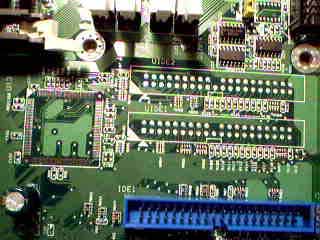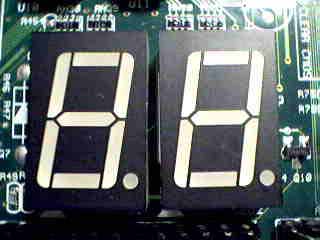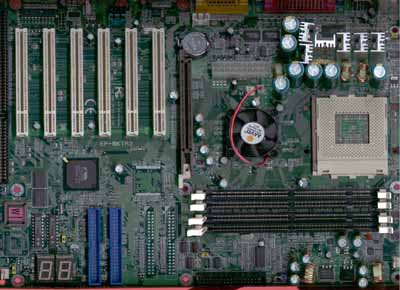VIA KT133A Motherboard Roundup - June 2001
by Mike Andrawes on June 13, 2001 2:52 PM EST- Posted in
- Motherboards
EPoX EP-8KTA3
|
EPoX EP-8KTA3 |
|
|
CPU
Interface
|
Socket-A
|
|
Chipset
|
VIA KT133A |
|
Form
Factor
|
ATX
|
|
Bus
Speeds
|
100 / 102 / 104 / 106 / 107 / 108 / 109 / 110 / 111 / 112 / 113 / 114 / 116 / 118 / 120 / 124 / 127 / 130 / 133 / 140 / 145 / 150 / 155 / 160 / 166 MHz |
|
Core
Voltages Supported
|
-0.1 / -0.075 / -0.05 / -0.025 / +0.025 / +0.05 / +0.075 / +0.125 / +0.150 V |
|
I/O
Voltages Supported
|
+0.05
/ +0.10 / +0.15 / +0.20 / +0.25 / +0.30 / +0.35 V
|
|
AGP
Voltages Supported
|
+0.1
/ +0.2 / +0.3 / +0.4 / +0.5 V
|
|
Memory
Slots
|
4
168-pin DIMM slots
|
|
Expansion
Slots
|
1
AGP Slot |
|
On-board
Audio
|
VIA
VT1611A AC'97 CODEC
|
|
BIOS
|
Award Medallion BIOS 6.00 |
The EPoX EP-8KTA3 is one of the few KT133A motherboards that actually has physical
layout changes. Fortunately, these changes appear to be for the better. Compared
to their KT133 solution, the EP-8KTA2, the most useful change is the migration
of multiplier ratio settings from dipswitches to the BIOS. As we have discussed
before, having the multiplier ratio settings inside the BIOS makes overclocking
much easier for people with an unlocked CPU.
However, FSB speed options are something EPoX did not take seriously. Although the FSB is adjustable inside the BIOS, 1MHz increments are not available. Indeed there are only six settings that are above 133MHz, which means that there are gaps of at least 5MHz between settings, which could prevent you from maximizing your CPU's overclocking potential.
On the other hand, EPoX did a good job in the voltage tweaking department, by not only including CPU core and I/O voltage settings, but also AGP voltage controls. Our tests show that by raising the I/O and AGP voltage, you can make the board more stable in overclocked situations, so the added feature is definitely a plus. The AGP voltage adjustments mainly come in handy when overclocking the AGP bus, which occurs whenever the FSB is also overclocked.
The EP-8KTA3 is much more stable than the EP-8KTA2, crashing just two times in 24 hours of stress testing, tying the ABIT KT7A-RAID. Once again, this is not the best result we have seen with KT133A boards, but is definitely very stable among all boards we have ever looked at.
The expansion slot configuration of the EP-8KTA3 is quite impressive with its six PCI slots, one ISA slot, and no AMR slot. This type of setup is probably most desired among hardware enthusiasts out there.
The board we received did not include onboard IDE RAID, but EPoX does offer the option and it comes with the EP-8KTA3+, which is otherwise identical. The EP-8KTA3+ includes Highpoint's HPT370 IDE RAID controller, the same that ABIT uses on a number of their boards, including the KT7A-RAID included here. Like the ABIT KT7A-RAID, there is support for RAID 0, RAID 1, or RAID 0+1 functionality or it can be used as just a second IDE controller for connecting an additional 4 drives.

The silkscreen for the Highpoint IDE RAID controller
For diagnosing problems, EPoX also used the release of the EP-8KTA3 to introduce their new diagnostic tool, the P80P LED Debugging Display. On the front of the board, you can see two 8 segment LED displays. During boot-up they will show two hexadecimal values representing the state of the system. If the machine fails to boot correctly, you would be able to use this two digit code to find out what the problem is associated with. The advantage of this setup is that it can store a total of 256 states, which is considerably more than the 16 states represented by most current diagnostic tools out there which use four LED's.

EPoX's new diagnostic tool
To enhance overclocking and improve stability, EPoX also installed a full HSF unit on the 8363A North Bridge, as well as heatsinks on the voltage regulator's MOSFETs closest to the CPU.
In general, the EP-8KTA3 is a solid board, with quite a few overclocking features for us. The downside is the lack of 1MHz increments for FSB speed selection, which affects our overclocking results, and the performance of the board, which is merely average.











0 Comments
View All Comments